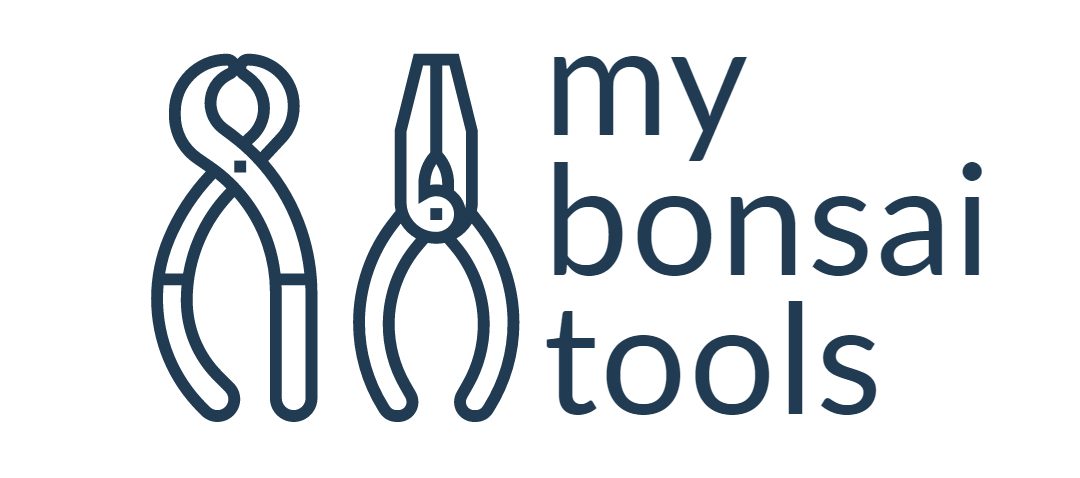In this post we will be talking about bonsai tools for begineers.
Essential Bonsai Tools for beginners
In our online bonsai shop you will find a fast service where you have the best tools within 24 hours and in many cases with free shipping at home.
Types and Uses for working with your bonsai tree.
We have prepared you a guide to buying bonsai tools that will help you enjoy the work on your trees.
There are many tools of different types and sizes, such as: Scissors, jin pliers, wire cutters…
Sometimes to find a especiality store near your home is difficult .
mybonsaitools staff
We have selected a wide range of tools online for design, cultivate and care your bonsai
One of the things we enjoy the most with our bonsai is when we do some sort of work, such as pruning, pinching, or repotting. For this we have to buy certain accessories for bonsai. It is true that there are many online stores where you can buy bonsai and tools.
This is one of those to buy specialty tools for certain jobs. Among the basic tools for bonsai we find the concave branch cutter (kuikiri) and scissors for bonsai. From here, a world of opportunities opens up to enjoy and train our bonsai.
If you are looking for tools for your bonsai that will help you in many tasks such as pruning, wiring, repotting, etc., this is undoubtedly the most important reason why you need to buy some of them.
Performance ratio that our products offer. Your passion is our passion. We welcome you again in the best online tool shop. We hope you enjoy any work you do with your tree and do not hesitate to contact us for any kind of information or questions.
How to use bonsai tools
Bonsai tools are utensils that always aim to maintain a good condition of our tree. There are many tools of different types and sizes, such as: Scissors, scissors, pliers, wire cutters …
Their essential function is to remove those parts of the trunk, branches, leaves or roots that do not aesthetically look like the design we give the bonsai.
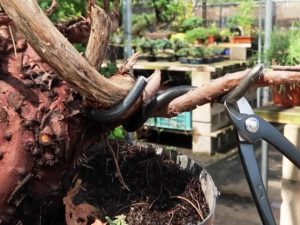
Most of them are made of stainless steel, so you can work with moisture even when the ground is wet or freshly watered.
All of these tools are necessary as a whole because they perform different functions and help your bonsai look good and grow healthy.
I’ll go through each of the tools that a bonsaiyist amateur have in his bonsai tool case and the tools that all of us use every day sort of what their purpose is, what they’re called and how we will use them on our tree.
Tools for begineer
There are different tools of carbon alloy or stainless steel, both in scissors, cutters or pliers. And also in many different sizes. It is useful to have a view
The first tool and probably the most important tool for a begineer are the shears.
There are differents shears models but I’ll use this for all my pruning during black pine season. I’ll use this for candle cutting and I’ll use this basically to cut smaller branches.
The tools that mybonsaitools.com recommend are basically a good shears.
You don’t have to get a japan brand , these are expensive.
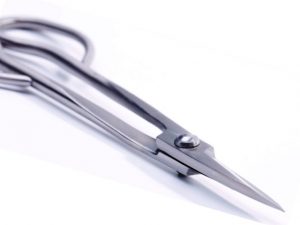
Buds and triming shears
You can just get them in carbon steel or maybe in stainless steel made in China tool and those are much more affordable and they serve thesame function.
Tools made in China is fine and a good Shear is essential.
If I have to get into a bigger branch, I’ll move into a concave branch cutter just so I don’t just to make sure I don’t damage my shear but this is this is great for reaching into hard-to-reach places.
A well finished shear is extremely durable and if it is carbon steel, it stays sharp for a very long time.
The root cutter
The root cutter iss pretty easy and self-explanatory.
It’s called a root cutter because it’s basically used to cut roots it the design of it.
Has a very very sharp tip that makes it extremely easy to cut roots. In fact, it’s easy to cut the root exactly at where you need to. If it’s high up in close to where the tap root is, you can get very close with this.
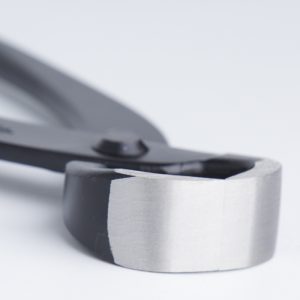
It’s extremely sharp and you don’t actually have to apply much of course to make a big root cut sothis is great.
The other use we use for this tool that most people don’t realize they can use it for is for working on “jin” and dead wood.
If you go in at an angle you can peel away dead wood extremely easy with this tool just because of how powerful it is and sort of how sturdy it is.
The spherical cutter
The next tool is the knob cutter known as “Kobukiri” in Japan. In this case there is al least four different sizes. 180mm, 200mm, 260mm and the biggest, 370mm. A true beast.
This is for cutting knobs off of your tree.
If you have a cut which may be healed incorrectly, you might get sort of a bulge on the trunk and that’s going to look unsightly so you will use this knob cutter to kind of chomp away and create sort of a divot in the trunk.
What happens is when you do that is the cambium or the new growth will appear flat at the trunk instead of having sort of a bulge so if it was sort of chomp away and that’s sort of why it’s shaped like that you can kind of see that.
The small one probably you can sort of give a little bit more torque on it is a lot easier to chew away at sort of harder dead wood and you can with the larger one so it’s actually better to have a smaller one in your tool kit.
If you can as opposed to having only one, a big one it’s also good to have.
Pliers for bonsai
the “jin” pliers
This is probably one of the essential tools to have. One of the major tools are the jin pliers.
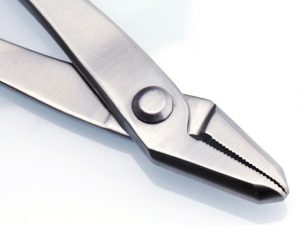
That is the reason I have two. Most people will use the jin pliers hence the name for creating jin and we can typically use this to sort of when you have a jin you can squeeze it to separate the cambium from the dead wood and then you can grab an end and sort of peel away at it to expose sort of the dead wood in the hardwood.
That’s one way of doing it for creating “jin” though typically.
I’ll just use one of these and just scrape up the cambium and it’s much safer and much easier but this is this sort of traditional tool for creating jin.
We can use this tool more for bending branches of a big tree but I won’t be able to bend it with my hand so in that case, we wiill use both of these grab two ends of the wire and twist with this to give me a little bit more leverage.
And we will be able to bend that branch in to sort of or give that movement that I wouldn’t have been able to If we were just using the hands.
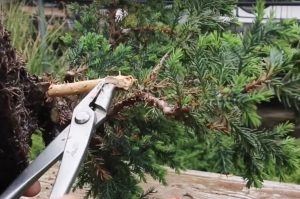
So jin pliers are great for creating jin but they’re also great for bending branches.
they’re also great for just sort of stabilizing something, holding something in place when you’re working with the tree in a repotting, for example, to create sort of hold the wiring guide wire or tighten it so those are jin pliers pretty essential.
Kumade
Then now the repotting stick (or rake, Kumade in Japanese). You wilI use this from repotting for loosening soil it’s kind of you know just having a little bit thicker and wider and bigger just makes it a little bit more ergonomic when working with a bigger tree.
A saw for cut branchs
The keyhole saw. This saw can easily cut through any major branch so if we can’t get through it with a concave branch cutter because it is extremely thick I’ll just pull this out and I’ll just cut away at the whole thing.
Usually what that will leave is sort of a just a big cut a flat cut and then from there wi will use my kobukiri, my knob cutter to chew away and to remove that sort of cut. if it’s a jin we use the jin plier or the my root cutter here to sort of develop the wood that will became jin
People basically assad’s for cutting major major major branches and it doesn’t look like much but it can cut through a branch extremely quick.
Dead wood tools
The last few tools we wanto to explaien is a chisel, a type of carving tools, to work with dead wood junipers pretty frequently.
This is pretty specialized tool I’ll just use this to peel away the bark to expose sort of the dead wood underneath with the chisel.
That is mostly the purpose of this and this again have dozen of and different shape.
Wire cutter
Probably the next most often used tool is the wire cutter if you work your bonsai with wire Specially with junipers these come in really handy. Usually we will hold this in our hand while we wire, that way we can easily snip off the wire once I’m done once I reach the end and then I can continue.
The wire scissors

This type of handle makes it extremely easy to use and this sort of blunt tip here ensures that when you cut the wire off of the branch you won’t accidentally dig into the branch and possibly damage the branch or break it so this is a great tool.
There is another bigger wire cutter. This big one is great for cutting anything over three millimeter wire. The smaller one is great for cutting in anything three millimeter and less but once again to
The 8″ wire cutter
Next tool is the basic wire cutter. In 8″ size or the big one.
Anything bigger you might damage this wire cutter if you use it so it’s good to have one of these in your tool kit just so you can cut the really, really thick wire and this thing cuts it through like butter.
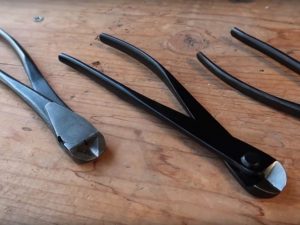
The nice thing about having a bigger wire cutter is that you cancut a smaller wire too as opposed to how you have the smaller wire cutter, you know you sort of get max of after three millimeters to get so you might damage the tool.
It’s actually better just to have one big one and this will cut all your wire sizes. If you’re not wiring too much then this you won’t actually pull this one.
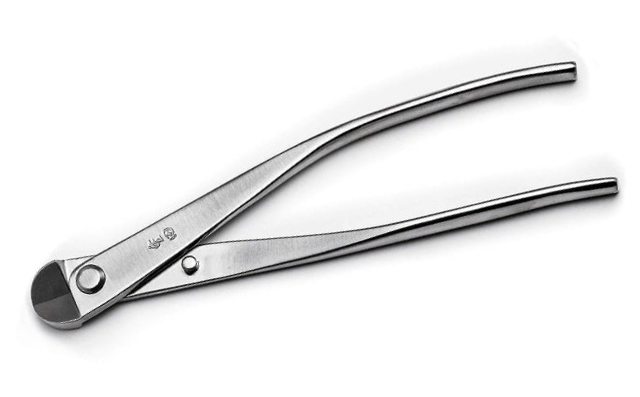
I do recommend not getting just a regular sort of hardware store wire cutter because the point on those it’s a little sharp at the tip and that will always end up cutting right into your branch.
The concave cutter
The next tool is a the concave branch cutte (call Kuikiri in Japan) and as Kobukiri have four sizes as well.
The options are the oppostite criteria to select a knob cutter. You must have the small one (175mm), the normal sized (205mm) one and you´ve got the monster concave branch cutter.
the way that cut you can see how it’s shaped kind of angled and what that does is it makes it extremely easy to cut off an entire branch cleanly right at the trunk or wherever you need it to be whether it be a secondary branch or a primary branch.
I think that everybody should have is just the concave branch cutter. I talk about the last, but this is extremely important.
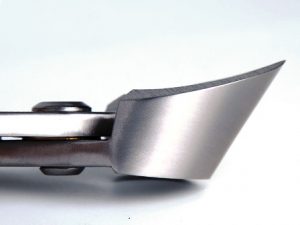
You will be cutting branches when working with your bonsai tree all the time and you just want something that will make that nice clean cut and make it easier for you to make the branch cut without them struggling and that’s what the concrete branch cutter is for.
If You end up using your shears, you have to make sure you try to cut it at the sort of the closest parts of the joint, to give you the most sort of the sort of leverage .
When you’re cutting it that way you don’t damage the tip but if you have to cut a thick branch you know it’s always best to use a concave branch cutter . That is what they are designed for.
I would definitely recommend one of these .
Short if I were just to have three was in my entire toolkit that I think I could get away with working on a tree and I could only bring the three tools I would bring these three they would be:
- The shears.
- The wire cutter because you’ll have to be cutting wire.
- A concave branch cutter.
If I just have even just these tools here I can almost work on any of my trees assuming I don’t have to make any major cuts and sort of that’s why this comes in handy so generally those are the the tools that you must have in your palm side tool kit.
Everybody’s tool kit is going to be different but those are sort of the basic ones that a beginner must to use.
